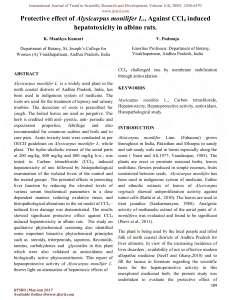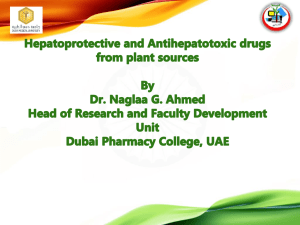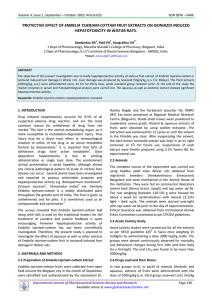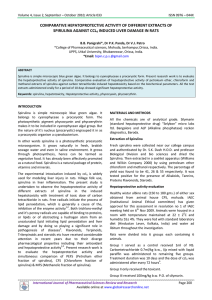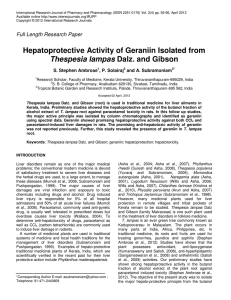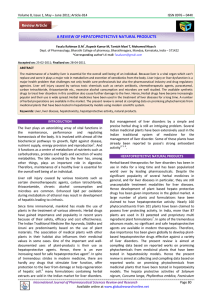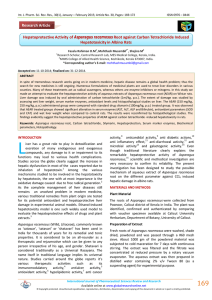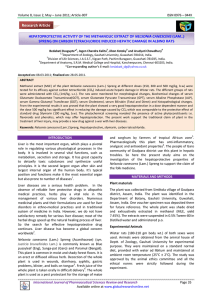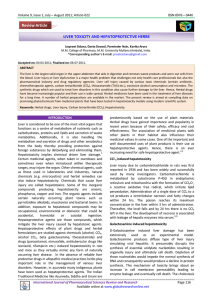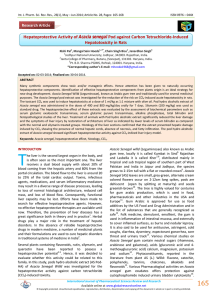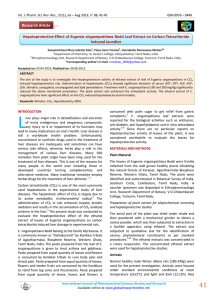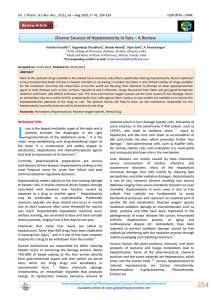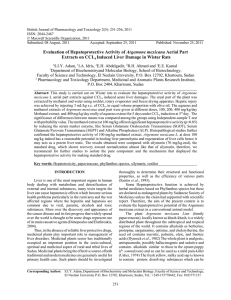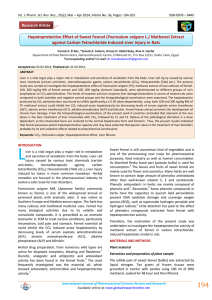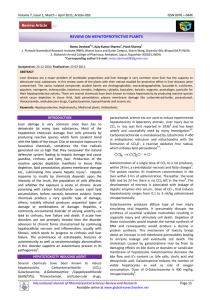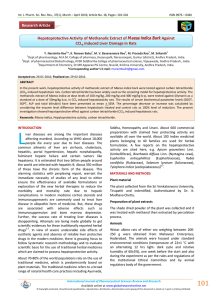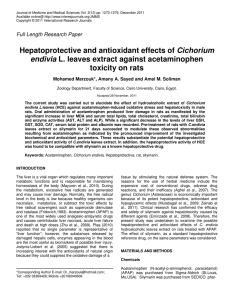Document 13308282
advertisement
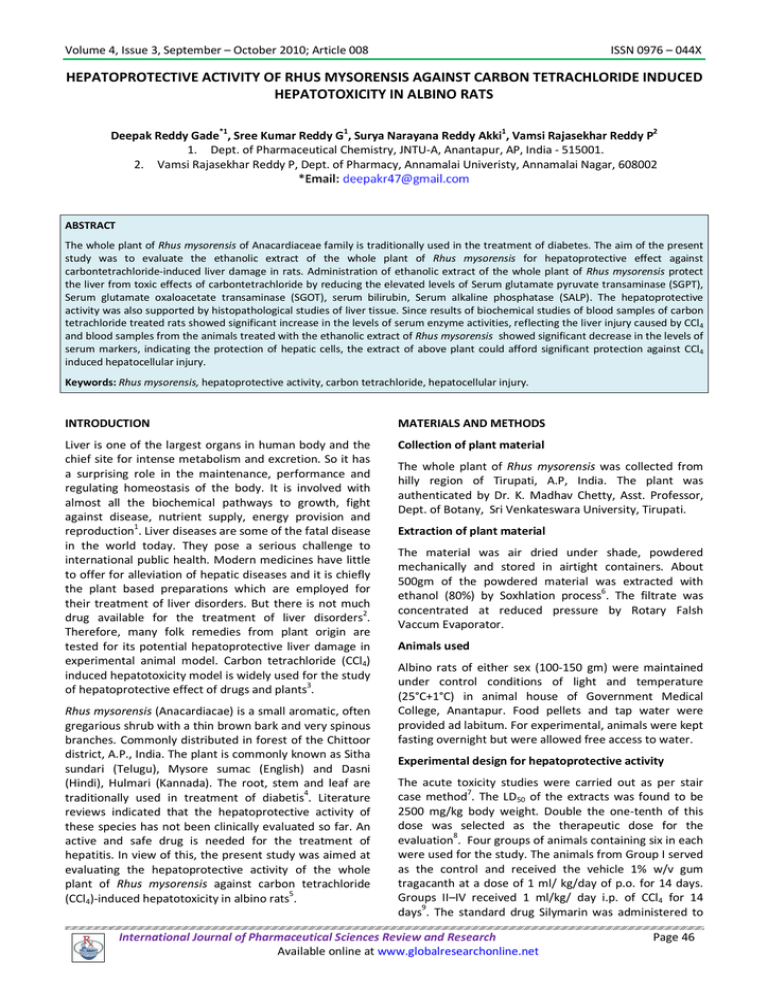
Volume 4, Issue 3, September – October 2010; Article 008 ISSN 0976 – 044X HEPATOPROTECTIVE ACTIVITY OF RHUS MYSORENSIS AGAINST CARBON TETRACHLORIDE INDUCED HEPATOTOXICITY IN ALBINO RATS Deepak Reddy Gade*1, Sree Kumar Reddy G1, Surya Narayana Reddy Akki1, Vamsi Rajasekhar Reddy P2 1. Dept. of Pharmaceutical Chemistry, JNTU-A, Anantapur, AP, India - 515001. 2. Vamsi Rajasekhar Reddy P, Dept. of Pharmacy, Annamalai Univeristy, Annamalai Nagar, 608002 ABSTRACT The whole plant of Rhus mysorensis of Anacardiaceae family is traditionally used in the treatment of diabetes. The aim of the present study was to evaluate the ethanolic extract of the whole plant of Rhus mysorensis for hepatoprotective effect against carbontetrachloride-induced liver damage in rats. Administration of ethanolic extract of the whole plant of Rhus mysorensis protect the liver from toxic effects of carbontetrachloride by reducing the elevated levels of Serum glutamate pyruvate transaminase (SGPT), Serum glutamate oxaloacetate transaminase (SGOT), serum bilirubin, Serum alkaline phosphatase (SALP). The hepatoprotective activity was also supported by histopathological studies of liver tissue. Since results of biochemical studies of blood samples of carbon tetrachloride treated rats showed significant increase in the levels of serum enzyme activities, reflecting the liver injury caused by CCl4 and blood samples from the animals treated with the ethanolic extract of Rhus mysorensis showed significant decrease in the levels of serum markers, indicating the protection of hepatic cells, the extract of above plant could afford significant protection against CCl4 induced hepatocellular injury. Keywords: Rhus mysorensis, hepatoprotective activity, carbon tetrachloride, hepatocellular injury. INTRODUCTION MATERIALS AND METHODS Liver is one of the largest organs in human body and the chief site for intense metabolism and excretion. So it has a surprising role in the maintenance, performance and regulating homeostasis of the body. It is involved with almost all the biochemical pathways to growth, fight against disease, nutrient supply, energy provision and reproduction1. Liver diseases are some of the fatal disease in the world today. They pose a serious challenge to international public health. Modern medicines have little to offer for alleviation of hepatic diseases and it is chiefly the plant based preparations which are employed for their treatment of liver disorders. But there is not much 2 drug available for the treatment of liver disorders . Therefore, many folk remedies from plant origin are tested for its potential hepatoprotective liver damage in experimental animal model. Carbon tetrachloride (CCl4) induced hepatotoxicity model is widely used for the study 3 of hepatoprotective effect of drugs and plants . Collection of plant material Rhus mysorensis (Anacardiacae) is a small aromatic, often gregarious shrub with a thin brown bark and very spinous branches. Commonly distributed in forest of the Chittoor district, A.P., India. The plant is commonly known as Sitha sundari (Telugu), Mysore sumac (English) and Dasni (Hindi), Hulmari (Kannada). The root, stem and leaf are traditionally used in treatment of diabetis4. Literature reviews indicated that the hepatoprotective activity of these species has not been clinically evaluated so far. An active and safe drug is needed for the treatment of hepatitis. In view of this, the present study was aimed at evaluating the hepatoprotective activity of the whole plant of Rhus mysorensis against carbon tetrachloride (CCl4)-induced hepatotoxicity in albino rats5. The whole plant of Rhus mysorensis was collected from hilly region of Tirupati, A.P, India. The plant was authenticated by Dr. K. Madhav Chetty, Asst. Professor, Dept. of Botany, Sri Venkateswara University, Tirupati. Extraction of plant material The material was air dried under shade, powdered mechanically and stored in airtight containers. About 500gm of the powdered material was extracted with ethanol (80%) by Soxhlation process6. The filtrate was concentrated at reduced pressure by Rotary Falsh Vaccum Evaporator. Animals used Albino rats of either sex (100-150 gm) were maintained under control conditions of light and temperature (25°C+1°C) in animal house of Government Medical College, Anantapur. Food pellets and tap water were provided ad labitum. For experimental, animals were kept fasting overnight but were allowed free access to water. Experimental design for hepatoprotective activity The acute toxicity studies were carried out as per stair case method7. The LD50 of the extracts was found to be 2500 mg/kg body weight. Double the one-tenth of this dose was selected as the therapeutic dose for the evaluation8. Four groups of animals containing six in each were used for the study. The animals from Group I served as the control and received the vehicle 1% w/v gum tragacanth at a dose of 1 ml/ kg/day of p.o. for 14 days. Groups II–IV received 1 ml/kg/ day i.p. of CCl4 for 14 days9. The standard drug Silymarin was administered to International Journal of Pharmaceutical Sciences Review and Research Available online at www.globalresearchonline.net Page 46 Volume 4, Issue 3, September – October 2010; Article 008 ISSN 0976 – 044X Group III animals in the dose of 100 mg/kg/ day p.o. for 14 days. While, Group IV was treated with ethanol extract of R. mysorensis in the dose of 500 mg/kg/day, p.o. (as per acute toxicity studies) for 14 days, respectively. The CCl4, silymarin and the extracts were administered concomitantly to the respective groups of animals. representative blocks of liver tissues from each lobe were taken and possessed for paraffin embedding hepatoprotective activity of ethanol extract of Rhus mysornsis against carbon tetrachloride-induced hepatotoxicity in rats using the standard 10 microtechnique . Sections (5 µm) of livers stained with hemotoxylin and eosin, were observed microscopically for histopathological studies. Assessment of hepatoprotective activity In the present study the hepatoprotective activity was evaluated biochemically and histopathologically. After 72 hours of drug treatment, the animals were dissected under ether anesthesia. Blood from each rat was withdrawn from carotid artery at the neck and collected in previously labeled centrifuging tubes and allowed to clot for 30 min at room temperature. Serum was separated by centrifugation at 3000 rpm for 15 minutes. The separated serum were used for the estimation of some biochemical parameters like Alanine aminotransferase (ALT/SGPT), Aspartate aminotransferase (AST/SGOT), Serum Alkaline Phosphatase (SALP) and bilirubin. For histopathological study, liver from each animal was removed after dissection and preserved in 10% formalin. Then RESULTS AND DISCUSSION The hepatoprotective activity results are expressed as mean±SEM of six animals from each group. The data were evaluated by one-way ANOVA statistical method. P values <0.01 were considered statistically significant. The administration of CCl4 to the animals resulted in a marked increase in total bilirubin, Alanine aminotransferase (ALT/SGPT), Aspartate aminotransferase (AST/SGOT), Serum Alkaline Phosphatase (SALP) activities. The toxic effect of CCl4 was controlled in the animals treated with the ethanolic extract by way of restoration of the levels of the liver function biochemistry similar to that of the standard drug silymarin (Table 1). Table 1: Effect of ethanolic extract of Rhus mysorensis on CCl4-treated rats Design of treatment Dose (mg/kg) Liver (wt/100g body wt) SGPT U/L SGOT U/L SALP U/L Total bilirubin Control 1ml/kg 3.6 ± 0.10 133.5±1.98 43.3±0.80 158.6±3.79 0.71±0.03 CCl4 1ml/kg 6.4 ± 0.28 216.3 ± 4.5 339.5± 3.8 385.6±1825 2.12±0.01 Silymarin+CCl4 100 3.9± 0.26* 139.0±2.17** 80.3±9.10* 215.6±5.47** 0.79±0.07* 137.0±2.17** 65.0±5.79* 290.6± 5.32* 0.80±0.01* Ethanolic 500 4.3± 0.05* extract+CCl4 N = 6 animals in each group. *P < 0.001; **P < 0.01 when compared with control. Values are expressed as Mean ± SEM. It was observed that the size of the liver was enlarged in CCl4-intoxicated rats but it was normal in drug-treated groups. A significant reduction (P < 0.001) in liver weight supports this finding. Histopathological examination of the liver section of the rats treated with toxicant showed intense centrilobular necrosis and vacuolization. The rats treated with silymarin and extract along with toxicant showed sign of protection against these toxicants to considerable extent as evident from formation of normal hepatic cards and absence of necrosis and vacuoles. Liver tissue rich in both transaminase increased in patients with acute hepatic diseases, SGPT which is slightly elevated by cardiac necrosis is a more specific 11 indicator of liver disease .Decrease in serum bilirubin after treatment with the extract in liver damage indicated the effectiveness of the extract in normal functional status of the liver. The preliminary phytochemical studies revealed the presence of flavonoids in ethanolic extract of R. mysorensis; various flavonoids have been reported for their hepatoprotective activity12. So the hepatoprotective effect of R. mysorensis may be due to its flavonoid content. REFERENCES 1. Ward, F.M. and Daly, M.J, Hepatic Disease In: Clinical Pharmacy and Therapeutics, Churchill Livingstone, New York, 1999, 195-212. 2. Sharma A., Chakraborti K.K. and Handa, S.S., Antihepatotoxic activity of some Indian herbal formulations as compared to silymarin, Fitoterapia, 62, 1991, 229-235. 3. Rubinstein, D., Epinephrine release and liver glycogen levels after carbon tetrachloride administration, American Journal of Physiology, 203, 1962, 1033–1037. International Journal of Pharmaceutical Sciences Review and Research Available online at www.globalresearchonline.net Page 47 Volume 4, Issue 3, September – October 2010; Article 008 4. Madhava Chetty K, Sivaji K, Tulasi Rao K, Flowereing Plants of Chittoor District Andhra Pradesh India, Student Offset Printers, Tirupati, 2008, 76. 5. Lima T. B, Suja A, Jisa O.S, Sathyanarayanan S, Remya k.S, Hepatoprotective activity of LIV-First against carbon tetra chloride–induced hepatotoxicity in albino rats, International journal of Green pharmacy, 2010, 71-74. 6. Kokate C.K., Practical Pharmacognosy, 4th Edition, Nirali Prakasan, Pune, 2006, 71-73. 7. Ghosh MN. Fundamentals of experimental pharmacology. 3rd Edition, Hilton and Co., kolkata, 2005, 92. 8. Jalalpure S.S, Patil M.B, Prakash N.S, Hemalata K, Manvi F.V, Hepatoprotective activity of fruits of ISSN 0976 – 044X Piper longum Linn., Indian Journal Pharmaceutical Sciences, 65, 2003, 360-366. 9. of Jaiprakash B, Aland R, Karadi R.V, Savadi R.V, Hukkeri VI. Hepatoprotective activity of fruit pulp of Balanites aegyptiaca, Indian Drugs, 40, 2003, 296297. 10. Galigher, A. E. and Kozloff, E. N., Essential Practical Microtechnique, 2nd Edition, Lea and Febiger, Philadelphia, 1971, 77–210. 11. Rodwell, V. W, Martin, D. W, Mayg P. A, and Garnner, D. K., Harper Review of Biochemistry, 20th Edition, Lange Medical Publisher, Calfornia, 1983, 62. 12. Scevola, D., Baebacini, G. M., Grosso, A., Bona, S. and Perissoud, D., Boll Inst Sieroter Milan, 63, 1984, 77–82. ************ International Journal of Pharmaceutical Sciences Review and Research Available online at www.globalresearchonline.net Page 48
